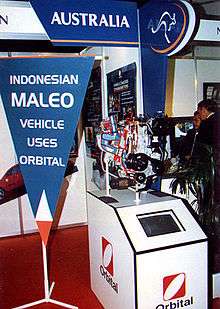Sarich orbital engine
The Sarich orbital engine is a type of internal combustion engine, invented in 1972 by Ralph Sarich,[1] an engineer from Perth, Australia, which features orbital rather than reciprocating motion of its internal parts. It differs from the conceptually similar Wankel engine by using a generally prismatic shaped rotor that orbits the axis of the engine, without rotation, rather than the rotating trilobular rotor of the Wankel.

Overview
The theoretical advantage is that there is no high-speed contact area with the engine walls, unlike in the Wankel engine in which edge wear is a problem. However, the combustion chambers are divided by blades which do have contact with both the walls and the rotor, and are said to have been difficult to seal due to the perpendicular intersection with the moving impeller.[2]
Sarich worked on the concept for a number of years without ever producing a production engine. A prototype was demonstrated, running on the bench with no load. The engine, which produces very high revs, has eight moving parts in the six-chambered version depicted in the patent application, plus valves for each chamber. It can supposedly be powered by compressed air or steam[3] and can be run as a pump.
In the patent, the engine is described as two-stroke internal combustion engine,[3] but the patent claims that with a different valve mechanism it could be used a four-stroke engine.[3]
A blower is required as the two stroke cycle does not provide suction to draw the mixture into the chamber.[3]
Technical problems
The Sarich orbital engine has a number of fundamental unsolved problems that have kept it from becoming a usable engine. Some key components cannot be cooled and others cannot readily be lubricated, so it is very susceptible to overheating.[4] At one press conference at which Sarich presented the engine, automotive engineer Phil Irving (designer of the Vincent Motorcycle and Brabham Formula One engines) pointed out a number of technical difficulties. Some processes developed for the engine could be used for other engines, such as the Orbital Combustion Process, an air/fuel precompresser for injection.[5]
Drawings
 perspective view with the exhaust end cover and chamber end plates removed
perspective view with the exhaust end cover and chamber end plates removed as before but with the vane and cam member also removed
as before but with the vane and cam member also removed
References
- Louise Fleming (2004). Excel HSC Business Studies. Pascal Press. pp. 59–. ISBN 978-1-74125-071-8.
Another disaster was the Federal Government doling out funds to assist Ralph Sarich develop his revolutionary orbital engine. In 1972, he won an inventors' competition and a few years later he floated the company on the stock exchange.
- Philippine Technology Journal. 22-23. Science and Technology Information Institute. 1997. pp. 17–.
While the Wankel engine rotor has line contact with the internal surface of the housing, the concentric rotary vane internal combustion engine rotor has plane contact with the cylinder. Wankel engine is basically an orbital engine because its ...
- "Rotary motor".
- "Fuel saving follies". ABC Radio National: Ockham’s Razor. 30 August 2009. Retrieved 29 June 2012.
- John Ettlie (7 June 2007). Managing Innovation. Routledge. pp. 204–. ISBN 978-1-136-38386-1.
Direct Injection: The Orbital Combustion Process An Australian company named Orbital Engine started working on cleaner burning two-stroke engines in the 1980s. The company developed a unique pump for direct injection systems, and at ...
External links
| Wikimedia Commons has media related to Orbital engines. |